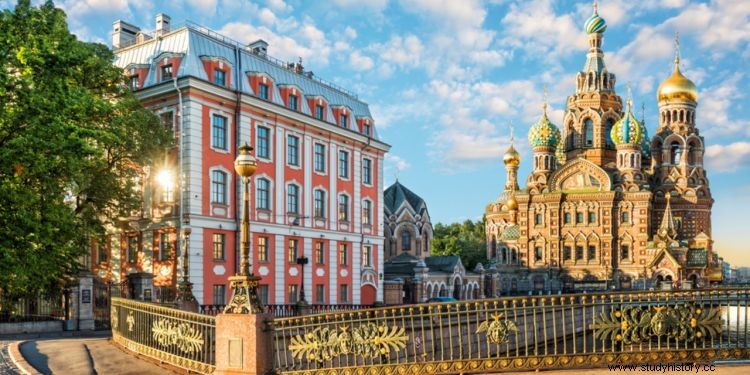 Historical capital of Russia, architectural gem, intellectual and academic center, Saint-Petersburg is the second largest city in the country and one of its main ports and rail hubs. Saint-Petersburg is first and foremost the idea of one man, the Tsar of Russia Peter I the Great. Few observers would have believed that just three years after seeing his army destroyed at Narva by his Swedish enemy Charles XII, Peter would succeed in taking control of Ingria from the Swedes. Now, on May 27, 1703, the sovereign laid the first stone of what he intended to become the first port of his empire, his window on the world and, ultimately, his capital.
Historical capital of Russia, architectural gem, intellectual and academic center, Saint-Petersburg is the second largest city in the country and one of its main ports and rail hubs. Saint-Petersburg is first and foremost the idea of one man, the Tsar of Russia Peter I the Great. Few observers would have believed that just three years after seeing his army destroyed at Narva by his Swedish enemy Charles XII, Peter would succeed in taking control of Ingria from the Swedes. Now, on May 27, 1703, the sovereign laid the first stone of what he intended to become the first port of his empire, his window on the world and, ultimately, his capital. Walking up Moscow Avenue in Saint Petersburg
An unhealthy swamp bordering the Neva, at the very bottom of the Gulf of Finland (ice-covered in winter), surrounded by forests which are still only occupied Swedish territory:such is the incongruous site chosen by Pierre. A choice that some will have called madness, but which will nevertheless place the tsar among the great builders of history. Because his company will succeed and Saint-Petersburg, voluntarily baptized with a Western and not Russian-sounding name, will become one of the jewels of the world's cultural and architectural heritage, at the same time as a metropolis steeped in history.
Dreams of grandeur, however, do not exclude pragmatism and the first thing to build is a fortress, in order to prevent the Swedes from regaining control of the region. Dedicated to Saints Peter and Paul, it will be erected on an islet in the Neva delta, Hare Island (Zayachyy ostrov ), which it completely encompasses. Wood will soon give way to stone in the construction of the ramparts – not without the foundations being secured by deeply driven piles, to prevent the granite from sinking into the loose soil of the marsh. This marsh, moreover, it is necessary to drain it and it is the Russian peasants who will take care of it. Reduced to the status of serfs, they have no say in any case, and it is by the tens of thousands that they are purely and simply deported to carry out the will of their master. The St. Petersburg History Museum now preserves eloquent digital records of these "rehoused", from Novgorod or elsewhere, who will be thousands to die of exhaustion, malnutrition and disease while draining the swamps . The tourist who arrives at Pulkovo airport hardly suspects these torments when arriving in the second city of modern Russia (4.5 million inhabitants). His first concern is to make it to his hotel alive after his taxi raced up Moscow Avenue at breakneck speed – 90 km/h or more, speed limits seeming to have little effect on the enthusiasm of motorists , no more than snow or rain when there is any. The race costs between 800 and 1200 rubles (20 and 30 euros):plan to have the account, because the driver could do you the trick of the one who has no change. Welcome to Russia!
The tourist who arrives at Pulkovo airport hardly suspects these torments when arriving in the second city of modern Russia (4.5 million inhabitants). His first concern is to make it to his hotel alive after his taxi raced up Moscow Avenue at breakneck speed – 90 km/h or more, speed limits seeming to have little effect on the enthusiasm of motorists , no more than snow or rain when there is any. The race costs between 800 and 1200 rubles (20 and 30 euros):plan to have the account, because the driver could do you the trick of the one who has no change. Welcome to Russia!Nevertheless, the city is huge and even at this speed, going up Moscow Avenue takes a good quarter of an hour before getting stuck in the traffic of the hypercentre. This gives the passenger time to contemplate, for example, the monument erected in memory of the Second World War:several sets of statues (workers, soldiers, sailors, civilians) overhung by an obelisk stamped with the dates “1941-1945”. Exit, therefore, Poland, the Baltic States or Finland:no war of aggression for Soviet historiography!
We will also remember the statue of Lenin – they were not all unbolted, far from in need – which sits in front of a vast building of typically Stalinist architecture, or even the few colored bell towers which appear between the trees of a vast park. Or, more prosaically, the enormous stalactites of ice which hang down, in winter, from roofs and channels, silently threatening the customers of the countless shops and other sushi-bars, which have become very fashionable, which flourish along the av. Stalactites in the image of Russia:beautiful, but sometimes merciless.
Vasili Island and the Menshikov Palace
In the mind of Peter the Great, the heart of his future capital should have been west of the Peter and Paul Fortress (Petropavlovskaya krepost’ ), on another island in the Neva delta, Vasily Island (Vassilievskyy ostrov ). Eventually, it was supposed to contain the main administrative buildings and be completely surrounded by ramparts. Designed on the model of Amsterdam, where Pierre had lived in 1697-98, it was also to be criss-crossed by canals:three main ones in the east-west direction, named according to their size, and cut at right angles by "lines », smaller and numbered compared to their docks.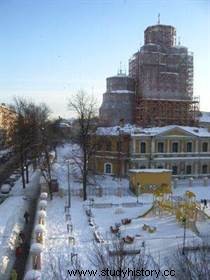 But when Peter died in 1725, none of this had been completed. The nerve center of the city was to remain where the palaces of the tsars were, on the south bank of the Neva. Never filled with water, the main canals would turn into avenues:the Great (Bolchoï prospekt , pronounce “balchoi praspiekt”), the Middle (Srednyy ) and, very originally, the little one (Malyy ). The "lines" would become so many streets, while keeping the numbering they should have had as channels. Thus, the Sixth and Seventh lines, for example, are in fact two sides of the same street – a peculiarity that cannot be found elsewhere in St. Petersburg.
But when Peter died in 1725, none of this had been completed. The nerve center of the city was to remain where the palaces of the tsars were, on the south bank of the Neva. Never filled with water, the main canals would turn into avenues:the Great (Bolchoï prospekt , pronounce “balchoi praspiekt”), the Middle (Srednyy ) and, very originally, the little one (Malyy ). The "lines" would become so many streets, while keeping the numbering they should have had as channels. Thus, the Sixth and Seventh lines, for example, are in fact two sides of the same street – a peculiarity that cannot be found elsewhere in St. Petersburg.If Vasily Island did not go not play its intended role as a city center, it was not going to be neglected for all that, hosting many buildings, in particular at the eastern tip of the island, where the Neva, which measures at this place almost a kilometer wide, gives rise to its two main arms. Among them is one of the very first stone buildings in the city, the Menshikov Palace. If it could have been built in stone, moreover, it was primarily because the Tsar had forbidden construction with this material anywhere other than St Petersburg, in order to ensure that the site of the new capital is supplied with both stones and masons.
The palace, as its name suggests, was the home of Alexander Menshikov, youth companion of Peter the Great who became his right arm. This man of uncertain origins – we do not know whether he was a commoner or a minor nobility – even became de facto regent on the death of Catherine I, the widow of Peter the Great who had succeeded him, before the great families of the Russian nobility fail to overthrow it. Stripped of all his possessions, Menshikov was exiled to Siberia with his family; he died there in poverty in 1729.
His palace, well restored after being neglected for a long time, is now a museum. The decoration is sometimes ostentatious, between Dutch earthenware tiles and Chinese silk tapestries, but it remains a palace for living rather than for pageantry. As a result, it offers an important contrast with the other, later and more ostentatious buildings that can be found on the south bank.
Here, a small aside on Russian museums is in order. Be aware that, with some exceptions, taking pictures inside requires paying a supplement at the entrance (usually 200 to 400 rubles, or between 5 and 10 euros). If it can be dispensed with in large museums, where the crowds make any control impossible, on the other hand it is better not to think about it in the smallest ones:each room contains a supervisor, most often an elderly lady who is not there for his pleasure, but to supplement his meager pension (generally between 5,000 and 10,000 rubles a month). These ladies keep an eye on things with all-Russian severity, which can turn into an almost disarming friendliness if you know their language and deign to speak to them a few words. This explains why this series of articles will be more readily illustrated with exterior than interior photos…
Serial museums
A little further than the Menshikov Palace, the square dedicated to Mikhail Lomonossov (1711-1765) sets the tone. Lomonossov was indeed a polymath, brilliant jack-of-all-trades at ease in poetry as well as in mathematics or in mosaic making. Like his genius, a large part of the tip of Vassili Island is dedicated to science and the arts. Thus, the Twelve Colleges, which according to the plan of Peter the Great were to house the ministries, finally housed a university – as well as, in an adjoining building and until 2009, the French University College of St. Petersburg.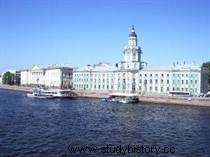
The continuation of the quay, upstream towards the tip of the island, is only a series of museums:to that of zoology succeeds that of anthropology and ethnology, installed in the Kounstkamera :the building where Pierre I had implanted, in the purest tradition of the 18th century, his cabinet of curiosities – sometimes morbid, ranging from the two-headed fetus to the skeleton of a giant. The building is surmounted by a tower which housed an astronomical observatory. The two buildings fill the quay to the Palace Bridge (Dvortsovyy most ) and the tip of Vassili Island itself.
On either side of the latter – converted into an esplanade – two rostral columns have been erected to the glory of the Russian Navy. The site offers a remarkable view of the south bank and the upstream Neva, including the Peter and Paul Fortress and the Winter Palace. It is very popular with Petersburgers, especially at weddings, and there is practically not a day without one not crossing, indeed, a couple of newlyweds being photographed, Mr. in a suit and Mrs. in a white dress – whatever the weather and the season. They say that drinking champagne (or, for lack of a better word, champanskoyé) , an excessively sweet sparkling wine which generally takes its place in Russia) brings good luck, and assures the traveler of returning to St. Petersburg.
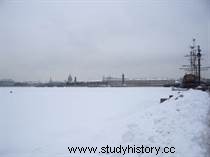 Facing the rostral columns is the Old Stock Exchange. Completed in 1811, it bears the weight of the architectural fashion of the time:neo-classical Greek colonnade of rigor, therefore. The whole (the Bourse and the rostral columns) was designed by a French architect, Thomas de Thomon. After the October Revolution, the building obviously lost its raison d'être, becoming very originally a... museum, in this case (and quite naturally given its location) that of the Navy - as indicated the white flag stamped with a blue St. Andrew's cross, symbol of the Russian navy, which overlooks it.
Facing the rostral columns is the Old Stock Exchange. Completed in 1811, it bears the weight of the architectural fashion of the time:neo-classical Greek colonnade of rigor, therefore. The whole (the Bourse and the rostral columns) was designed by a French architect, Thomas de Thomon. After the October Revolution, the building obviously lost its raison d'être, becoming very originally a... museum, in this case (and quite naturally given its location) that of the Navy - as indicated the white flag stamped with a blue St. Andrew's cross, symbol of the Russian navy, which overlooks it.Inside, the large main hall immerses you in three centuries of Russian naval history, from botik , a small boat on which Peter the Great learned to sail, during the First World War. Busts and decorations of admirals, models of ships and materials of all kinds are available to you, while from the ceiling hang large trophies:flags of ships taken from the Swedes at Gangut (today Hankö in Finland) in 1714, a victory that was to assure the Russians of control of the Baltic Sea; then later, to the Turks, during the countless wars that opposed Russia to the Ottoman Empire.
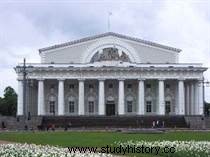 The exhibition, however, does not stop there:a series of smaller side rooms allow to continue the journey through time, from the October Revolution to the present day. Several of them are devoted to the often little-known operations carried out by the Soviet fleet during the Second World War, whether in the Baltic or the Black Sea. We'll see one of the 305 mm shells – huge projectile with a sharp point, almost as high as you – that the battleships Marat and Oktyabrskaya Revolutsiya firing on the German lines during the siege of Leningrad, or even a Polikarpov I-16 naval aviation fighter hanging from the ceiling. . The most we can recommend to him, in order to make the most of his visit, is to go there early – the museum closes at 5 p.m. – and not to hesitate, contrary to the author of this article, to pay the 350 rubles corresponding to the authorization to photograph, even if it means jabbering the few words of Russian that he will know or making himself understood with supporting gestures. St-Petersburg was therefore born there, on this “Hare Island” now entirely occupied by the massive Peter-and-Paul Fortress. With a plan typical of its time, it forms an irregular hexagon, at the corners of which protrude bastions, each bearing a name. Two half-moons (kinds of advanced positions) cover the eastern and western ends and above all, the two main entrances. The high walls of pink granite, pierced with loopholes and bristling with cannons, had the mission both to repel an assault from land, and to prevent an opposing fleet from forcing the course of the Neva. The opportunity never arose and by the end of the 18th century the building had essentially lost its original defensive function.
The exhibition, however, does not stop there:a series of smaller side rooms allow to continue the journey through time, from the October Revolution to the present day. Several of them are devoted to the often little-known operations carried out by the Soviet fleet during the Second World War, whether in the Baltic or the Black Sea. We'll see one of the 305 mm shells – huge projectile with a sharp point, almost as high as you – that the battleships Marat and Oktyabrskaya Revolutsiya firing on the German lines during the siege of Leningrad, or even a Polikarpov I-16 naval aviation fighter hanging from the ceiling. . The most we can recommend to him, in order to make the most of his visit, is to go there early – the museum closes at 5 p.m. – and not to hesitate, contrary to the author of this article, to pay the 350 rubles corresponding to the authorization to photograph, even if it means jabbering the few words of Russian that he will know or making himself understood with supporting gestures. St-Petersburg was therefore born there, on this “Hare Island” now entirely occupied by the massive Peter-and-Paul Fortress. With a plan typical of its time, it forms an irregular hexagon, at the corners of which protrude bastions, each bearing a name. Two half-moons (kinds of advanced positions) cover the eastern and western ends and above all, the two main entrances. The high walls of pink granite, pierced with loopholes and bristling with cannons, had the mission both to repel an assault from land, and to prevent an opposing fleet from forcing the course of the Neva. The opportunity never arose and by the end of the 18th century the building had essentially lost its original defensive function. On the beach...
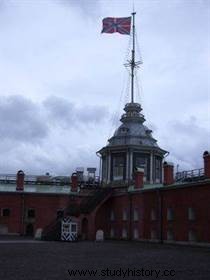 The visitor arriving from Vasily Island has several possible choices if he wants to enter the fortress. He can go as close as possible and enter it directly, but it is more interesting to go around it by the banks of the Neva. Unusual spectacle in the heart of a city of this size, once bypassed the bastion Troubetskoy, there is ... a beach. The space under the ramparts is often used to erect tents and grandstands, and in summer the beach is transformed into a popular leisure spot for the people of Petersburg.
The visitor arriving from Vasily Island has several possible choices if he wants to enter the fortress. He can go as close as possible and enter it directly, but it is more interesting to go around it by the banks of the Neva. Unusual spectacle in the heart of a city of this size, once bypassed the bastion Troubetskoy, there is ... a beach. The space under the ramparts is often used to erect tents and grandstands, and in summer the beach is transformed into a popular leisure spot for the people of Petersburg.We enjoy swimming there, despite the uninviting aspect of the brownish and notoriously polluted waters of the river. In winter too, by the way:it is here that the “Morses”, as they are called, strip naked before briefly diving through a hole previously made in the ice. It would seem that the hardest part would be getting out of the water, since the air temperature in winter is generally lower than that of the water. However, most people who venture to the frozen Neva to drill a hole are content to fish there – a popular pastime in Russia, whatever the season.
The beach s stops at the foot of the Naryshkin bastion, which faces the Winter Palace. The bastion is surmounted by a small tower, which made it possible to observe the navigation on the Neva, and by a boat mast on top of which floats the flag of the governor of the fortress – which is also the other standard of the navy. Russian, in addition to that with the blue St. Andrew's cross. The tourist who finds himself there around noon, if he is not warned, would have, as soon as the clock struck the twelfth stroke of the Peter-and-Paul basilica, the surprise of having his eardrums torn by the explosion of a huge firecracker, surprisingly loud for anyone who hadn't had the opportunity to hear a field gun up close.
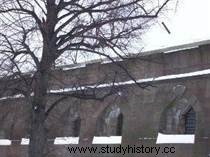 It is indeed one of two 10.5 cm guns – guns taken from the Germans during the Second world war – installed on the Naryshkin bastion, which strikes midday every day in its own way. A few seconds later, the visitor still stunned by the penetrating explosion receives the echo, sent back by the facade of the palaces on the other bank. In winter, the effect is striking because being relatively far from the incessant car traffic of the city center, the place is quite quiet.
It is indeed one of two 10.5 cm guns – guns taken from the Germans during the Second world war – installed on the Naryshkin bastion, which strikes midday every day in its own way. A few seconds later, the visitor still stunned by the penetrating explosion receives the echo, sent back by the facade of the palaces on the other bank. In winter, the effect is striking because being relatively far from the incessant car traffic of the city center, the place is quite quiet. The necropolis of the tsars
Pass the Naryshkin bastion to reach the Neva gate:in addition to the two main entrances, this one allowed access to the fortress by river. The massive gray stones that constitute it contrast with the rest of the ramparts. Let's now enter the fortress proper. On the left, a staircase leads to the Naryshkin bastion, one of the few places in the city from which it is possible to have a wide panorama. Access, however, is chargeable, as with the rest of what can be found inside the Peter and Paul Fortress.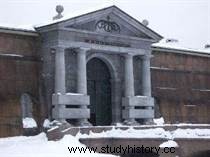 Indeed, the fortified islet is filled to the brim with museums. The ticket office, located in a small pavilion facing the basilica, offers an interesting and economical formula:a “pass” giving access to the five main sites of the fortress, including photos – something rare. A little anecdote, the ticket office also houses a reproduction of the botik of Peter the Great, in which it seems customary to throw small coins. In all sincerity, the author of his lines does not know if this custom has a very precise vocation, or if it is just a means for the Russians to get rid of their more cumbersome 1 and 5 kopeck coins in a timely manner. than anything else given their extremely low face value:they would be worth more at the cost of scrap metal.
Indeed, the fortified islet is filled to the brim with museums. The ticket office, located in a small pavilion facing the basilica, offers an interesting and economical formula:a “pass” giving access to the five main sites of the fortress, including photos – something rare. A little anecdote, the ticket office also houses a reproduction of the botik of Peter the Great, in which it seems customary to throw small coins. In all sincerity, the author of his lines does not know if this custom has a very precise vocation, or if it is just a means for the Russians to get rid of their more cumbersome 1 and 5 kopeck coins in a timely manner. than anything else given their extremely low face value:they would be worth more at the cost of scrap metal.While the primary use of the Peter-and-Paul Fortress was military, it was also intended to become a sanctuary. What was to become the eponymous basilica was also one of the very first things built, once the first stone was laid, with the aim of becoming the necropolis of the Russian imperial family. Beneath the huge golden spire, surmounted by an emblematic figure of the archangel, rest several dozen grand dukes and grand duchesses – all related to the tsars – and above all, almost all the sovereigns who reigned over Russia between 1689 and 1917, except for the short-lived and little-known Peter II and Ivan VI, dead and buried elsewhere.
 The place is absolutely splendour. But the splendor is such in the palaces and churches of St. Petersburg that you get used to it very quickly, and if you had visited the Hermitage Museum the day before, the basilica would seem almost sober. Everything is relative:we are talking here about colored marbles, crystalline chandeliers and ubiquitous gilding. Below, the tombs seem almost humble:white marble surmounted by a golden Orthodox cross, a plaque of the same quality recalling the identity of the illustrious deceased buried there. The only ones who escape this rule are Alexander II and his wife, who rest in large porphyry sarcophagi, red for the tsar, black for the tsarina.
The place is absolutely splendour. But the splendor is such in the palaces and churches of St. Petersburg that you get used to it very quickly, and if you had visited the Hermitage Museum the day before, the basilica would seem almost sober. Everything is relative:we are talking here about colored marbles, crystalline chandeliers and ubiquitous gilding. Below, the tombs seem almost humble:white marble surmounted by a golden Orthodox cross, a plaque of the same quality recalling the identity of the illustrious deceased buried there. The only ones who escape this rule are Alexander II and his wife, who rest in large porphyry sarcophagi, red for the tsar, black for the tsarina.Given the tumultuous history of the Romanov dynasty, the Fate has sometimes reserved a fate that is ironic to say the least for the remnants of the sovereign fires of all the Russias. We can thus see Catherine II resting alongside her husband Pierre III, overthrown in 1763 by a coup orchestrated by her and slain shortly after; or Alexander I lying alongside his father Paul I, assassinated in 1801 following a plot of which Alexander knew everything, but revealed nothing. Guilt would pursue him until his own death in 1825.
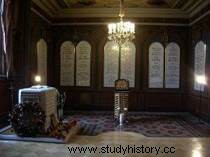 The last czar is elsewhere. A small chapel located away from the main nave houses the remains of Nicolas II, his wife Alexandra, their son Alexis and their four daughters Olga, Tatiana, Maria and Anastasia, as well as the four people from their retinue who were brutally murdered. with them, on the night of July 17 to 18, 1918. First burned and abandoned in a disused mineshaft in the region of Yekaterinburg in the distant Urals, their bodies were transferred there 80 years later; or at least nine of them, because the remains of Alexis and Maria were only found in 2007 at another site. The Tsar's family was canonized by the Orthodox Church of Russia and the chapel of the "Romanov saints" cannot be visited:it can only be photographed through the door.
The last czar is elsewhere. A small chapel located away from the main nave houses the remains of Nicolas II, his wife Alexandra, their son Alexis and their four daughters Olga, Tatiana, Maria and Anastasia, as well as the four people from their retinue who were brutally murdered. with them, on the night of July 17 to 18, 1918. First burned and abandoned in a disused mineshaft in the region of Yekaterinburg in the distant Urals, their bodies were transferred there 80 years later; or at least nine of them, because the remains of Alexis and Maria were only found in 2007 at another site. The Tsar's family was canonized by the Orthodox Church of Russia and the chapel of the "Romanov saints" cannot be visited:it can only be photographed through the door. Silent Peter and Paul Fortress
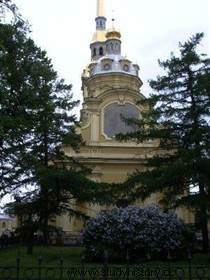 It is by meditating on this tragic and sordid end that one emerges from the basilica. The hammer and sickle frieze decorating the Hôtel des Monnaies (Monetny Dvor ), located opposite the basilica and where collector coins are still minted, recalls the deadly clash between the old regime and the new. On the other side of the religious building is another cemetery, that of the governors of the fortress. In June the place is almost charming, with its greenery and flowering lilacs; it would be easier to forget these dark thoughts there.
It is by meditating on this tragic and sordid end that one emerges from the basilica. The hammer and sickle frieze decorating the Hôtel des Monnaies (Monetny Dvor ), located opposite the basilica and where collector coins are still minted, recalls the deadly clash between the old regime and the new. On the other side of the religious building is another cemetery, that of the governors of the fortress. In June the place is almost charming, with its greenery and flowering lilacs; it would be easier to forget these dark thoughts there.But in February the atmosphere is quite different:the tombstones are covered with sheet metal shelters to protect them from the action of frost, and the chimes of the basilica, which sounds its haunting music every half hour, further thickens an almost lugubrious atmosphere. Even the statue of Peter the Great, created recently, is disturbing:the tsar is represented seated there, old and bald, with a severe air, a disproportionate body, skeletal fingers. All that is missing from this sinister and unreal picture are a few crows, which in St. Petersburg are more gray than black, moreover.
Not far from there, the fortress's history museum can be visited quite quickly . The one dedicated to the history of the city itself, installed in the former residence of the governor of the fortress, is much more extensive and is worth the detour. Both present a recently refurbished museography, with modern, didactic and well-presented exhibitions. The rooms devoted to the various objects of daily life are of particular interest.
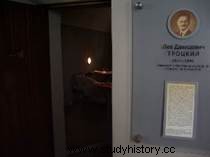 Due to its closed and insular nature, the Peter and Paul Fortress was ideal for accommodating prisoners "important" that we wanted to keep secret. This habit was formalized in the first half of the 19th century, when the Trubetskoy bastion was converted into a state prison. He thus received, under very difficult conditions, the political enemies of the tsarist regime, and some distinguished prisoners, such as the writer Fedor (first name which, in Russian, is actually pronounced "Fiodor" - in other words Theodore) Dostoyevsky during his "rebellious" youth, or Leon Trotsky, for a short period in 1907.
Due to its closed and insular nature, the Peter and Paul Fortress was ideal for accommodating prisoners "important" that we wanted to keep secret. This habit was formalized in the first half of the 19th century, when the Trubetskoy bastion was converted into a state prison. He thus received, under very difficult conditions, the political enemies of the tsarist regime, and some distinguished prisoners, such as the writer Fedor (first name which, in Russian, is actually pronounced "Fiodor" - in other words Theodore) Dostoyevsky during his "rebellious" youth, or Leon Trotsky, for a short period in 1907.During the Revolution, the prison was naturally used to house opponents of the Bolsheviks, before being abandoned in the 1920s and transformed into a museum. The layout is a bit monotonous – a series of cells with brief biographies of their main occupants – but gives a good glimpse of the very harsh conditions of their imprisonment, from the Spartan comfort of the plank beds to the sound insulation system, supposed to prevent the detainees from communicating with each other by knocking on the walls.
Before leaving, you still have to see the museum of the conquest of space. It is a bit of the poor relation of the fortress:slightly out of the way, it has not benefited from the recent developments of other museums. It is nonetheless interesting to visit, between the bust of Constantin Tsiolkovsky (the father of the theory of space travel), the full-scale model of Sputnik , or the food provided to the cosmonauts of the station Mir . The opportunity to see that even in space, the Russians carried (in a tube) their tvorog , sweet cream made from slightly acidic curds and which – at least on Earth – serves as the basis for excellent desserts. The heart of St. Petersburg was neither to be Vassili Island, as Peter the Great had imagined, nor the Peter and Paul Fortress where the first stone of the city had been laid. In fact, it is on the south bank of the Neva that the city center is located. The reason for this is essentially practical:in an absolute and highly centralized monarchy, it was ultimately logical that the palace of the tsar and autocrat of all the Russias should become the nerve center of the imperial capital.
Over the Neva
Two bridges make it possible to pass from Vassili Island to the left bank of the Neva:that of the Palace, already mentioned, and the bridge of Lieutenant Schmidt (Most Leytenanta Schmita , sometimes also called Blagoveshchenskyy Most , the Annunciation Bridge). Let's borrow the latter. The uninformed visitor will notice in the middle of the bridge some sort of sentry boxes. These are control posts, for the simple and good reason that this bridge rises, like all the other bridges on the Neva – which partly explains why there are so few of them, compared to French cities like Lyon or Paris , and relatively to the scale of the city. Indeed, the Neva connects the Baltic Sea with Lake Ladoga, which itself is connected by various channels to the rest of Russian waterways, including the Volga Basin. It is therefore an important axis of communication, with the passage of high tonnage ships. Blocked by ice for almost half the year, navigation is reopened as soon as the river is thawed. Obviously, the bridges cannot be raised piecemeal, given the impact this would have on car traffic.
Indeed, the Neva connects the Baltic Sea with Lake Ladoga, which itself is connected by various channels to the rest of Russian waterways, including the Volga Basin. It is therefore an important axis of communication, with the passage of high tonnage ships. Blocked by ice for almost half the year, navigation is reopened as soon as the river is thawed. Obviously, the bridges cannot be raised piecemeal, given the impact this would have on car traffic.There are therefore time slots during which the bridges are raised, at night, generally between one and five o'clock in the morning. This can be problematic for getting around the city, because the metro is closed from midnight to seven o'clock, so there is no longer any way to get from one bank to the other. The partygoer who, for example, wants to leave his hotel on Vassili Island to go and have fun in one of the many nightclubs on the south shore will only have to wait to get back.
In the worst case scenario, if it's June, he can always console himself by contemplating the magical spectacle of the raised bridges standing out in the milky, humid light of the famous "sleepless nights":the period of the summer solstice when, helping latitude, the sun practically does not set, and where the night is limited to two or three hours of twilight. Of course, around the winter solstice in December, it's the opposite:"black days" when you don't see the sun.
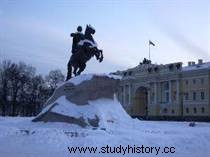 Fortunately for the night owl, Russia is not France:there is no closing by decreed by the prefect at one o'clock in the morning and most night establishments in Petersburg close much later. The same is true of cafes or restaurants, even certain stores, frequently open at hours that we would consider perfectly incongruous. St Petersburg is a city that never really stops:you can eat a chicken there at six in the morning – which won't necessarily be superfluous if you've drunk too much of the excellent local beer (piva in Russian), a drink much more widely consumed in Russia than vodka.
Fortunately for the night owl, Russia is not France:there is no closing by decreed by the prefect at one o'clock in the morning and most night establishments in Petersburg close much later. The same is true of cafes or restaurants, even certain stores, frequently open at hours that we would consider perfectly incongruous. St Petersburg is a city that never really stops:you can eat a chicken there at six in the morning – which won't necessarily be superfluous if you've drunk too much of the excellent local beer (piva in Russian), a drink much more widely consumed in Russia than vodka. The Bronze Horseman
Although they are also important, let us leave these few considerations on what makes the soul of St. Petersburg – which its inhabitants call more simply Piter – and continue on our way. On the left after the bridge, going up the Quai des Anglais (Naberezhnaïa Angliski ), you soon pass an imposing yellow building:this is the old Senate. At the time of the tsars, it was not a legislative body strictly speaking, but simply the place where the closest advisers of the sovereign met. It now houses the Constitutional Court of the Russian Federation, the highest judicial body in the country, recently transferred from Moscow to St Petersburg.Immediately after the Senate, we come face to face with one of the symbols the best known of St Petersburg, the monumental equestrian statue of Peter the Great. Perched on a pink granite monolith weighing more than a thousand tons, the Tsar extends his arm towards the newly conquered lands in an imperious posture, while his rearing horse tramples the Swedish serpent. L’ensemble a été conçu par un artiste français, Falconet, mais le socle porte pour toute légende une simple dédicace (en russe et en latin) :« À Pierre I er , Catherine II ". L’œuvre a été inaugurée en 1782, et les habitants de la ville l’appellent simplement « le Cavalier de Bronze ».
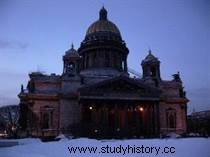 Elle doit ce surnom au poème éponyme d’Alexandre Pouchkine, écrit en 1833, et que des générations d’écoliers russes ont appris par cœur – la pédagogie russe est d’ailleurs basée sur ce type d’apprentissage, essentiellement. Le poète y chante son amour pour sa ville, et de fait, St-Pétersbourg est une cité dont on tombe aisément amoureux. Il y rappelle également les meurtrières inondations de 1827, qui avaient dévasté une grande partie de la ville. Pouchkine et la statue sont devenus, dans la culture russes, indissociables de la ville et, par la même occasion, en sont considérés par les Pétersbourgeois eux-mêmes comme des figures emblématiques.
Elle doit ce surnom au poème éponyme d’Alexandre Pouchkine, écrit en 1833, et que des générations d’écoliers russes ont appris par cœur – la pédagogie russe est d’ailleurs basée sur ce type d’apprentissage, essentiellement. Le poète y chante son amour pour sa ville, et de fait, St-Pétersbourg est une cité dont on tombe aisément amoureux. Il y rappelle également les meurtrières inondations de 1827, qui avaient dévasté une grande partie de la ville. Pouchkine et la statue sont devenus, dans la culture russes, indissociables de la ville et, par la même occasion, en sont considérés par les Pétersbourgeois eux-mêmes comme des figures emblématiques.La grande place qui accueille la statue se nomme « place des Décembristes ». C’est en effet ici qu’en décembre 1825, un groupe d’officiers de l’armée tenta un coup d’État libéral, à la mort d’Alexandre I er . En lieu et place de son successeur légitime, son frère Nicolas I er , les putschistes placèrent sur le trône un autre frère d’Alexandre, Constantin. Leurs soldats s’assemblèrent sur ce qui était alors la place du Sénat, aujourd’hui plantée d’arbres, mais qui à l’époque était nue. Toutefois, leur manœuvre échoua et leurs partisans furent écrasés dans le sang sur cette même place. Certains meneurs furent condamnés à mort et exécutés, les autres déportés en Sibérie avec leurs familles. Sous le régime soviétique, l’endroit fut rebaptisé place des Décembristes (Plochtchad’ Dekabristov ), bien que leur coup d’État n’eût rien d’une révolution populaire.
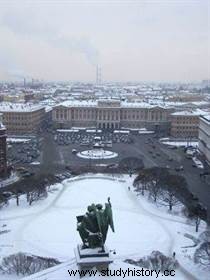 Panorama de Saint-Pétersbourg
Panorama de Saint-Pétersbourg
De l’autre côté de la place, on débouche sur la cathédrale Saint-Isaac (Isaakievskyy Sobor – prononcer ce dernier mot « sabor » car le premier « o » n’est pas accentué :une caractéristique récurrente, et assez déroutante, de la langue russe), tout à fait représentative d’une démesure, tant dans le luxe que dans la taille, typique de St-Pétersbourg. Son large dôme doré culmine à plus de cent mètres au-dessus du sol, et chacun des quatre bras de son plan en croix grecque est flanqué de colonnes de granit rose – omniprésent à St-Pétersbourg car c’était la roche la plus rapidement disponible, les carrières se situant en Finlande – hautes de 17 mètres. On passera sur les lourdes portes de bronze, face auxquelles le visiteur se sent bien petit.Pour éviter que sa colossale création ne s’enfonce dans le sol meuble de l’ancien marécage, l’architecte français – encore – Auguste de Montferrand le fit stabiliser en y insérant des milliers de pieux, chacun sur plusieurs mètres de profondeur. La construction s’échelonna sur quarante ans et s’acheva en 1858. Outre le musée qui s’y trouve, le principal intérêt de St-Isaac est l’escalier de quelques 200 marches qui, moyennant moins de 200 roubles, permet de monter jusqu’à la colonnade qui soutient le dôme. C’est là que vous aurez le meilleur panorama sur un centre-ville qui, autrement, est uniformément plat, et où les immeubles dépassent rarement cinq ou six étages.
On pourra découvrir à cette occasion… encore une autre place, avec une autre statue équestre, à l’opposé du Cavalier de Bronze :celle de Nicolas I er , le pourfendeur des Décembristes. Ce dernier fit construire face à celle-ci un palais pour sa fille Marie, d’où son nom de palais Mariinski. Celui-ci abrite aujourd’hui l’hôtel de ville de St-Pétersbourg. Sa façade arbore fièrement, comme un militaire le ferait sur sa poitrine, les décorations gagnées durant la Seconde guerre mondiale :Ordre du Drapeau Rouge, Ordre de Lénine, ville-héroïne de l’Union Soviétique…
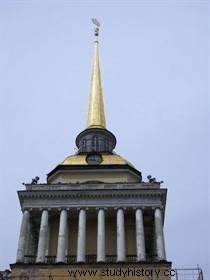 Des jardins de l'Amirauté à la place du Palais
Des jardins de l'Amirauté à la place du Palais
Repartons à présent de l’hôtel de ville, faisons demi-tour et dirigeons-nous de nouveau vers la Neva. À l’est de la place des Décembristes s’étendent l’Amirauté et ses jardins. Le bâtiment de l’Amirauté, lui aussi peint en jaune, n’avait pas seulement vocation à servir de quartier général (fonction qu’il remplit encore aujourd’hui, pour la flotte de la Baltique), mais également de chantier naval. Il adopte ainsi la forme d’un rectangle incomplet, avec le quatrième côté ouvert sur la Neva. Dans l’espace ainsi délimité étaient construits les bâtiments de la marine russe, jusqu’à ce que la sophistication croissante de l’ingénierie navale au XIXème siècle ne conduise à installer les chantiers navals plus près du golfe de Finlande, là où ils se trouvent encore actuellement. On en profita pour construire des immeubles dans l’espace ainsi laissé libre entre l’Amirauté et le fleuve.L’entrée du bâtiment (évidemment interdite au public de par sa fonction militaire) est surmontée d’une flèche dorée, au sommet de laquelle figure l’effigie du premier navire fabriqué ici, la frégate Standart . En-dessous s’étendent d’agréables jardins, qui fournissent au promeneur un havre de tranquillité relative au cœur d’une ville hyperactive :une fontaine, des massifs de fleurs, les bustes d’hommes de lettres, et celui de l’explorateur de la Sibérie et de l’Asie centrale, Prjewalski. Juste en-dessous de lui a été représenté le plus fidèle compagnon de ses voyages, un chameau. Un grand classique pétersbourgeois consiste à se faire photographier aux côtés du camélidé, comme en témoigne le bronze, poli et dépourvu de patine, du haut de la statue. Couvrant tout le côté nord de la place éponyme, le Palais d’Hiver y étale sa façade verte bardée de dorures, de statues et de colonnades blanches. Le gigantesque édifice est à l’échelle de sa ville et de son pays, et il faut compter un bon quart d’heure de marche soutenue pour en faire le tour complet, le palais donnant également sur la Neva. Ce n’est pas de trop pour abriter une des plus grands et des plus beaux musées de la planète, l’Ermitage. Avant d’y pénétrer, commençons d’abord par en faire le tour.
Ermitage et Palais d'Hiver
La première demeure de Pierre le Grand à St-Pétersbourg fut une modeste cabane de bois au confort plutôt spartiate, construite sur le modèle des isbas de la campagne russe. Le tsar n’était guère incommodé par ce type d’expédient et vécut dans cette demeure pendant huit ans – bien qu’il passât alors le plus clair de son temps ailleurs, dirigeant ses campagnes militaires contre les Suédois. Pieusement conservée jusqu’à nos jours, sa cabane se situe ailleurs dans la ville et se visite encore.C’est en 1711 qu’un premier palais fut construit sur le site actuel. Plusieurs autres suivirent, et ce n’est qu’après la mort de Pierre I er qu’ils furent réunis pour former la base de ce qui allait devenir le Palais sous sa forme actuelle. Entre temps, St-Pétersbourg avait connu les atermoiements liés aux intrigues de cour. Quand Pierre le Grand mourut en 1725, c’est sa veuve, Catherine I ère , qui lui succéda. Elle lui survécut deux ans, laissant sa place au petit-fils du défunt tsar, Pierre II. Mineur, placé sous la tutelle de princes conservateurs et opposés à la politique d’occidentalisation voulue par son grand-père, il fit revenir la Cour à Moscou, où il mourut prématurément en 1730.
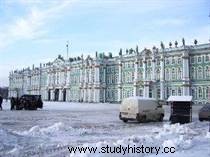 La tsarine Anne, qui lui succéda, fit marche arrière et rétablit St-Pétersbourg comme capitale de l’empire. C’est elle qui fera raser les divers palais établis sur la rive sud de la Neva pour n’en former qu’un seul. Elle en confiera la construction à l’architecte italien Bartolomeo Rastrelli, dont le père avait déjà été l’un des principaux architectes de la ville sous Pierre le Grand. La mort d’Anne en 1740 et le coup d’État qui mit sur le trône, l’année suivante (après le bref règne d’Ivan VI), la fille de Pierre le Grand, Élisabeth, ne remit pas en cause le statut de capitale de St-Pétersbourg, ni celui du Palais d’Hiver.
La tsarine Anne, qui lui succéda, fit marche arrière et rétablit St-Pétersbourg comme capitale de l’empire. C’est elle qui fera raser les divers palais établis sur la rive sud de la Neva pour n’en former qu’un seul. Elle en confiera la construction à l’architecte italien Bartolomeo Rastrelli, dont le père avait déjà été l’un des principaux architectes de la ville sous Pierre le Grand. La mort d’Anne en 1740 et le coup d’État qui mit sur le trône, l’année suivante (après le bref règne d’Ivan VI), la fille de Pierre le Grand, Élisabeth, ne remit pas en cause le statut de capitale de St-Pétersbourg, ni celui du Palais d’Hiver.C’est essentiellement sous le règne d’Élisabeth qu’il sera achevé. Plus tard, Catherine II fera construire une annexe au palais, dans le but avoué de s’y retirer lorsque les obligations de l’État lui devenaient trop pesantes. Grande amatrice d’art – et collectionneuse quasi compulsive, c’est là qu’elle commença à entreposer les œuvres dont elle faisait l’acquisition. Cette collection allait former le noyau du futur musée de l’Ermitage, qui occupe aujourd’hui tout le palais – si bien qu’on ne fait plus guère la distinction entre les deux et que « l’Ermitage » désigne le Palais d’Hiver, et inversement.
Le Palais devait rester la résidence officielle des tsars jusqu’en 1917, hormis un bref épisode sous le règne de Paul I er . Il fut dévasté par un incendie en 1837; la reconstruction qui s’ensuivit lui donna sa configuration actuelle. La collection d’œuvres d’art des souverains avait atteint une telle ampleur que l’Ermitage était désormais ouvert au public, dès la fin du XIX ème century. Le Palais, pour sa part, joua encore un rôle politique de premier plan en 1917. Lorsque Nicolas II fut contraint d’abdiquer à la suite de la révolution de Février, le gouvernement provisoire qui lui succéda s’y installa. Il constitua donc tout naturellement la cible principale des Bolchéviques lors de la révolution suivante, celle d’Octobre, durant laquelle il fut pris d’assaut.
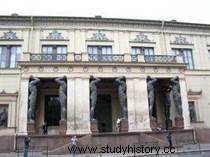 Une fois au pouvoir, le régime bolchévique s’en alla pour Moscou, et entreprit d’installer le musée de l’Ermitage dans l’ensemble de l’ancien palais impérial. Ce dernier allait beaucoup souffrir durant la Seconde guerre mondiale. Placé sous le feu quasi constant de l’artillerie allemande à partir de septembre 1941, il allait subir, pendant les 900 jours qu’allait durer le blocus, des dégâts considérables. Il fallut ensuite de longues années de restauration, une fois la guerre terminée, pour que les touristes puissent aujourd’hui en admirer la splendeur.
Une fois au pouvoir, le régime bolchévique s’en alla pour Moscou, et entreprit d’installer le musée de l’Ermitage dans l’ensemble de l’ancien palais impérial. Ce dernier allait beaucoup souffrir durant la Seconde guerre mondiale. Placé sous le feu quasi constant de l’artillerie allemande à partir de septembre 1941, il allait subir, pendant les 900 jours qu’allait durer le blocus, des dégâts considérables. Il fallut ensuite de longues années de restauration, une fois la guerre terminée, pour que les touristes puissent aujourd’hui en admirer la splendeur. Le musée Pouchkine à Saint-Pétersbourg
Le rappel de ces événements tragiques est l’occasion d’une brève digression sur les divers noms de la ville. On a vu que Pierre avait délibérément choisi un nom à consonance étrangère – en l’occurrence, germanique – pour en marquer l’ouverture vers l’Occident. De fait, Sankt-Peterburg est un nom complètement exotique pour un Russe. S’il existe en Russie de nombreuses villes dédiées à un ou plusieurs saints, l’épithète « Saint » n’y est jamais utilisé et de toute manière, ce mot se dit en russe sviatoï et non sankt , qui est un mot typiquement allemand.Pour cette raison, la poussée nationaliste et germanophobe qui accompagna en Russie le début de la Première Guerre Mondiale, poussa le tsar Nicolas II à rebaptiser sa capitale Petrograd en 1914. Ce n’était ni plus ni moins que la traduction littérale de Saint-Pétersbourg en russe, grad étant une altération de gorod (« ville »), un mot qui désignait initialement une cité fortifiée ou un château – exactement comme burg en allemand. À la mort de Lénine en 1924, la ville fut rebaptisée Leningrad pour lui rendre hommage, et garda ce nom durant toute la période soviétique. C’est en 1991 qu’elle retrouvera son nom initial, à la suite d’un référendum.
Délaissons le musée pour le moment – nous aurons l’occasion d’y revenir longuement. Après avoir longé la façade de l’Ermitage proprement dit, et la colonnade d’atlantes qui en marque l’ancienne entrée, on rejoint le quai de la Moïka. Contrairement à ce qui s’est produit sur l’île Vassili, la rive sud de la Neva a bien été dotée d’un réseau de canaux. Le centre-ville de St-Pétersbourg est délimité par trois canaux concentriques, baptisés (en allant du centre vers la périphérie) Moïka, Griboïedov et Fontanka, ce dernier étant le plus large.
Le quartier situé autour du cours supérieur de la Moïka abrite de nombreux consulats, dont celui de France. C’est donc par là-bas, amis touristes, qu’il vous faudra aller si par malheur vous auriez un problème suffisamment sérieux. Parmi les demeures qui s’étalent sur les rives de la Moïka, figure le dernier appartement qu’occupa le poète Alexandre Pouchkine. Meublé avec les objets ayant appartenu à l’homme de lettres, ou reconstitué à l’aide de la documentation disponible, il est devenu un musée qui lui est entièrement consacré.
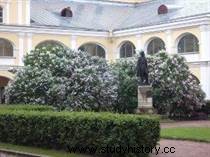 Il n’est pas exagéré de dire que Pouchkine est vénéré comme un saint à Pétersbourg – il nous a même été donné de voir, avec étonnement, une vieille dame se signer avant de pénétrer dans la cour menant à son appartement-musée. De fait, la capitale des tsars fut la principale source d’inspiration du poète, et les habitants de la ville lui reconnaissent d’avoir décrit et loué Saint-Pétersbourg mieux que personne. Sa mort tragique, à 37 ans, contribua encore à asseoir sa légende.
Il n’est pas exagéré de dire que Pouchkine est vénéré comme un saint à Pétersbourg – il nous a même été donné de voir, avec étonnement, une vieille dame se signer avant de pénétrer dans la cour menant à son appartement-musée. De fait, la capitale des tsars fut la principale source d’inspiration du poète, et les habitants de la ville lui reconnaissent d’avoir décrit et loué Saint-Pétersbourg mieux que personne. Sa mort tragique, à 37 ans, contribua encore à asseoir sa légende.Il se trouve en effet qu’Alexandre Pouchkine a été tué en duel par un Français, en 1837. Officier légitimiste auto-exilé en Russie en 1830, Georges d’Anthès avait été admis au sein de l’élite de la garde impériale russe, le régiment des Chevaliers-Gardes. Il avait eu le mauvais goût de courtiser la femme de Pouchkine tout en épousant la sœur de celle-ci et les deux hommes, d’invectives en lettres d’insultes, avaient fini par se battre en duel au pistolet, Pouchkine recevant une blessure mortelle à l’estomac. Quant à d’Anthès, il fut expulsé vers la France, terminant sa carrière comme sénateur sous le Second Empire.
Ces événements sont relatés par les audioguides multilingues qui sont automatiquement remis aux visiteurs de l’appartement-musée par un personnel très aimable – les Russes sont généralement très fiers de leur culture, et le sont plus encore de la partager. Compte tenu de la relative exiguïté des lieux, il est parfois nécessaire d’attendre avant de commencer la visite ou de passer d’une pièce à l’autre. Le port de chaussons de feutre est obligatoire afin de préserver le parquet, qui porte déjà de trop nombreuses marques de talons-aiguilles, accessoire féminin par excellence en Russie.
